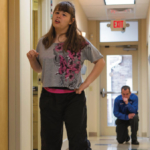Health in a postindustrial age: The mystery of our creaky, painful knees
Living longer and being fatter are part, but not all, of it.
Painful, stiff, and grating knees may not just be a sign of aging—they may also be a sign of the times.

An archaeological sample with traces of bone-on-bone contact. Heli Maijanen photo
Beth Mole, Ars Technica August 15, 2017
Painful, stiff, and grating knees may not just be a sign of aging—they may also be a sign of the times.
Degenerative knee arthritis, or knee osteoarthritis (OA), seems to be on the rise. Since the early part of the 20th century, its prevalence has doubled in Americans, according to a new study in PNAS. Researchers estimate that at least 19 percent of all US adults over the age of 45 now suffer from the condition, and it’s a leading cause of chronic pain. But, it’s unclear why. The most obvious suspects—longer lifespans and heftier bodies—don’t fully explain the aching jump in joint problems, researchers report.
But one thing that does seem clear is that our frames haven’t kept pace with our lifestyles. “From an evolutionary perspective, knee OA thus fits the criteria of a “mismatch disease” that is more prevalent or severe because our bodies are inadequately or imperfectly adapted to modern environments,” the researchers behind the study conclude.
For the study, led by human evolutionary biologist Daniel Lieberman of Harvard, the researchers examined nearly 2,600 skeletal remains to get a sense of how common knee OA was and is in the states. They scanned three groups of skeletons:
- 176 archeological skeletons of prehistoric Native American hunter-gatherers and early farmers (dating between 300 and 6,000 years ago);
- 1,581 early industrial remains of Ohio and Missouri residents who died between 1905 and 1940; and
- 819 postindustrial folks who died in New Mexico or Tennessee between 1976 and 2015.
The researchers looked for a common sign of OA around knee joints called eburnation, a hardening of bone that becomes ivory-like as cartilage erodes over time.
| Stiff data |
Knee OA was 2.6 times more prevalent in the postindustrial group than the early industrial group—with rates of 16 percent and 6 percent, respectively—the researchers found. The postindustrial group also had twice the prevalence of the prehistoric group, which was 8 percent.
When the researchers modeled the data, accounting for body-mass index (BMI) and age at death, knee OA prevalence was still 2.1 times higher in the postindustrial group than the early industrial one. This suggests that these factors, longer lives and the current obesity epidemic, don’t explain the increase.
It’s “commonly assumed” that higher knee OA is “simply an inevitable consequence of people living longer and more often having a high BMI,” the researchers conclude. But, “instead, our analyses indicate the presence of additional independent risk factors that seem to be either unique to or amplified in the postindustrial era.”
The researchers have hypotheses about what those factors might be. Lack of physical activity and chronic, low-grade inflammation exacerbated by crummy, Western diets, may play a role, they speculate. But they’ll need to do more research to figure it out. They also acknowledge that their study has limitations. For one thing, although they surveyed many skeletons, it’s unclear if they perfectly represent OA prevalence in each time frame. And the data only includes BMIs at death, so it’s not possible to know if people were heavier earlier in life.
Still, the authors say, the data points to other factors driving the prevalence of knee problems. And, as with other ‘mismatch diseases,’ those factors are likely preventable—we just need to identify them.
Source Ars Technica
| References |
Knee osteoarthritis has doubled in prevalence since the mid-20th century, Ian J. Wallace, Steven Worthington, David T. Felson, Robert D. Jurmain, Kimberly T. Wren, Heli Maijanen, Robert J. Woods, and Daniel E. Lieberman. PNAS 2017; published ahead of print August 14, 2017, doi: 10.1073/pnas.1703856114
Also see
Can exercise prevent knee osteoarthritis?






